busybox版本:1.35.0
ash程序入口分析
ash程序是linux内核启动后期进入busybox后,在busybox中启动的默认shell,用于响应和执行命令输入。ash的操作入口由ash_main()函数代表,定义在/shell/ash.c文件中。
贴上ash_main函数的完整代码(出自/shell/ash.c):
int ash_main(int argc, char **argv) MAIN_EXTERNALLY_VISIBLE; #if NUM_SCRIPTS > 0 int ash_main(int argc, char **argv) #else int ash_main(int argc UNUSED_PARAM, char **argv) #endif /* note: 'argc' is used only if embedded scripts are enabled */ { volatile smallint state; struct jmploc jmploc; struct stackmark smark; int login_sh; /* Initialize global data */ INIT_G_misc(); INIT_G_memstack(); INIT_G_var(); #if ENABLE_ASH_ALIAS INIT_G_alias(); #endif INIT_G_cmdtable(); #if PROFILE monitor(4, etext, profile_buf, sizeof(profile_buf), 50); #endif state = 0; if (setjmp(jmploc.loc)) { smallint e; smallint s; exitreset(); e = exception_type; s = state; if (e == EXEND || e == EXEXIT || s == 0 || iflag == 0 || shlvl) { exitshell(); } reset(); if (e == EXINT) { newline_and_flush(stderr); } popstackmark(&smark); FORCE_INT_ON; /* enable interrupts */ if (s == 1) goto state1; if (s == 2) goto state2; if (s == 3) goto state3; goto state4; } exception_handler = &jmploc; rootpid = getpid(); init(); setstackmark(&smark); #if NUM_SCRIPTS > 0 if (argc < 0) /* Non-NULL minusc tells procargs that an embedded script is being run */ minusc = get_script_content(-argc - 1); #endif login_sh = procargs(argv); #if DEBUG TRACE(("Shell args: ")); trace_puts_args(argv); #endif if (login_sh) { const char *hp; state = 1; read_profile("/etc/profile"); state1: state = 2; hp = lookupvar("HOME"); if (hp) read_profile("$HOME/.profile"); } state2: state = 3; if (iflag #ifndef linux && getuid() == geteuid() && getgid() == getegid() #endif ) { const char *shinit = lookupvar("ENV"); if (shinit != NULL && *shinit != '') read_profile(shinit); } popstackmark(&smark); state3: state = 4; if (minusc) { /* evalstring pushes parsefile stack. * Ensure we don't falsely claim that 0 (stdin) * is one of stacked source fds. * Testcase: ash -c 'exec 1>&0' must not complain. */ // if (!sflag) g_parsefile->pf_fd = -1; // ^^ not necessary since now we special-case fd 0 // in save_fd_on_redirect() lineno = 0; // bash compat // dash: evalstring(minusc, sflag ? 0 : EV_EXIT); // The above makes // ash -sc 'echo $-' // continue reading input from stdin after running 'echo'. // bash does not do this: it prints "hBcs" and exits. evalstring(minusc, EV_EXIT); } if (sflag || minusc == NULL) { #if MAX_HISTORY > 0 && ENABLE_FEATURE_EDITING_SAVEHISTORY if (line_input_state) { const char *hp = lookupvar("HISTFILE"); if (!hp) { hp = lookupvar("HOME"); if (hp) { INT_OFF; hp = concat_path_file(hp, ".ash_history"); setvar0("HISTFILE", hp); free((char*)hp); INT_ON; hp = lookupvar("HISTFILE"); } } if (hp) line_input_state->hist_file = xstrdup(hp); # if ENABLE_FEATURE_SH_HISTFILESIZE hp = lookupvar("HISTFILESIZE"); line_input_state->max_history = size_from_HISTFILESIZE(hp); # endif } #endif state4: /* XXX ??? - why isn't this before the "if" statement */ cmdloop(1); } #if PROFILE monitor(0); #endif #ifdef GPROF { extern void _mcleanup(void); _mcleanup(); } #endif TRACE(("End of main reached ")); exitshell(); /* NOTREACHED */ }
下文将分段描述该函数。
首先是调用几个INIT_G_XXX命名的宏定义:
INIT_G_misc(); INIT_G_memstack(); INIT_G_var(); #if ENABLE_ASH_ALIAS INIT_G_alias(); #endif INIT_G_cmdtable();
用于初始化全局变量。
然后将state变量值设置为0:
state = 0;
接着是调用一个C语言标准库中的setjmp()函数实现异常处理机制:
if (setjmp(jmploc.loc)) {
smallint e;
smallint s;
exitreset();
e = exception_type;
s = state;
if (e == EXEND || e == EXEXIT || s == 0 || iflag == 0 || shlvl) {
exitshell();
}
reset();
if (e == EXINT) {
newline_and_flush(stderr);
}
popstackmark(&smark);
FORCE_INT_ON; /* enable interrupts */
printf("s : %d
",s);
if (s == 1)
goto state1;
if (s == 2)
goto state2;
if (s == 3)
goto state3;
goto state4;
}
exception_handler = &jmploc;
在接下来的代码中,会调用procargs(argv)处理命令行参数;调用read_profile("/etc/profile")读取配置文件,这个文件正是在busybox中需要我们自己添加的用于配置shell的描述文件。
在最后,则会调用cmdloop(1)函数用于执行命令行循环操作。该函数用于读取执行命令。
ash_main总结
ash_main()函数用于初始化和解析参数,读取/etc/profile配置文件,然后调用cmdloop()来执行命令。setjmp()函数是一个C语言库函数,用于设置当事件发生时跳转到的位置。在异常发生时,变量"state"可用于计算跳转的位置。
login进程
在busybox运行后,在命令行下输入login命令则可以运行login程序,默认busybox配置下,在启动busybox后,会执行ash程序而不是login程序。在实际应用需求中,我们可以将login设置为busybox启动后的运行程序。方法如下:
(1)使用make menuconfig编译构建出busybox的图形配置界面,选择下列选项:
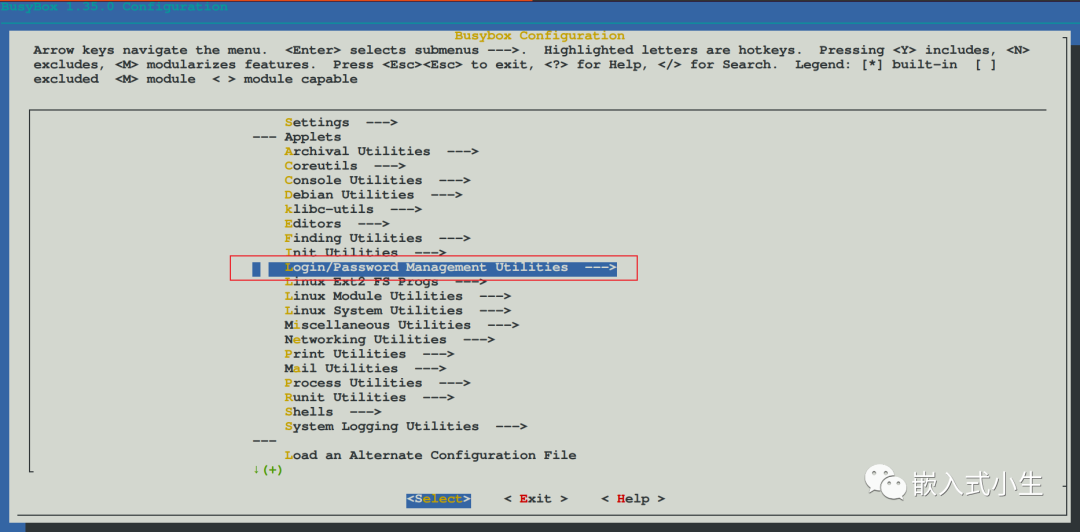
(2)进入Login/Password Management Utilities选项,将该配置下的所有项目都配置上:
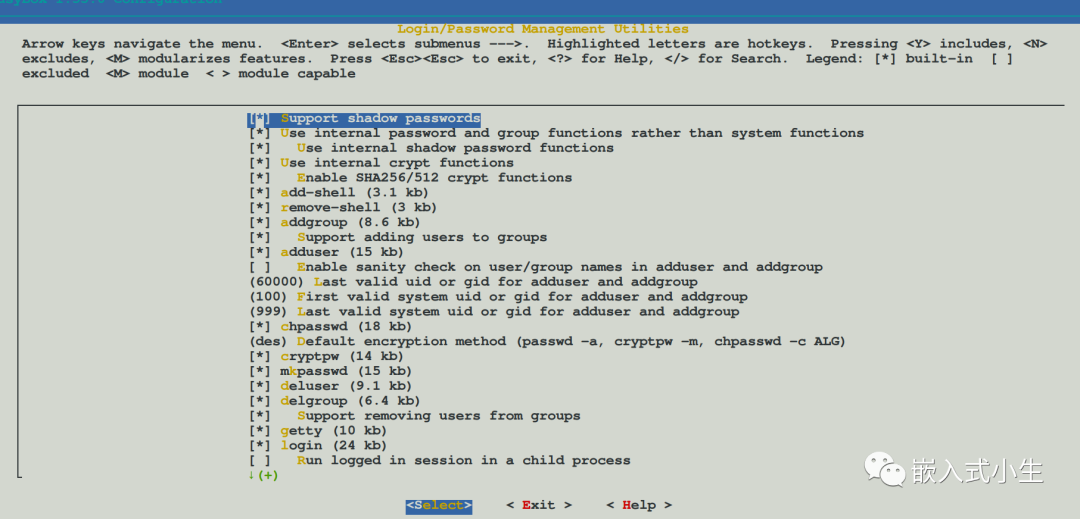
(3)使用make -j12编译构建busybox。
(4)安装busybox
通过以上步骤,这时候的busybox是支持login程序的,接下来,在/etc/inittab文件中设置启动项:
:-/bin/login 或者 :/sbin/getty 115200 console
注:上述配置任选一种
配置/etc/group,/etc/passwd,/etc/shadow三个文件(如果在busybox中没有,则需要自己创建)
在/etc/group文件中,添加如下配置:
root0:root
在/etc/passwd文件中添加root用户的密钥信息:
root0root:/root:/bin/sh
小生这里/etc/passed文件中内容如下:
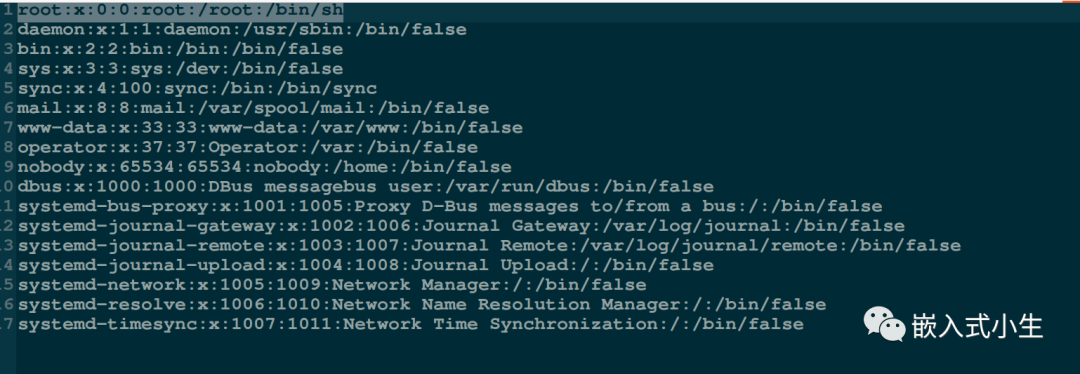
在/etc/shadow文件中配置用户(这里是root用户)密码:
root199999::
DH9Ade75qXIdI表示设置的密码
该串密文可使用mkpasswd命令生成,在命令行终端输入mkpasswd后会提示输入密码,这时候输入我们想要设置的明文密码,完成后按下回车键即可生成crypt格式的字符串:

上述操作就将login登录的密码设置为iriczhao,用户名为root。
至此,通过上述步骤,就完成了login的配置,运行busybox后,即可进入login程序,如下图所示:

键入root和密码(本文是iriczhao)后,即可进入shell。
login程序入口分析
根据busybox的工具特征,知道login程序对应的入口则是login_main(),本小节将分析该函数:
当在busybox中运行login程序后,会提示输入登录名,然后会提示输入密码,按下Enter键后,将会去验证登录密码是否正确,这一系列的操作是由login_main函数中的while(1){}结构完成的,代码如下(出自/loginutils/login.c):
while (1) {
/* flush away any type-ahead (as getty does) */
tcflush(0, TCIFLUSH);
if (!username[0])
get_username_or_die(username, sizeof(username));
#if ENABLE_PAM
pamret = pam_start("login", username, &conv, &pamh);
if (pamret != PAM_SUCCESS) {
failed_msg = "start";
goto pam_auth_failed;
}
/* set TTY (so things like securetty work) */
pamret = pam_set_item(pamh, PAM_TTY, short_tty);
if (pamret != PAM_SUCCESS) {
failed_msg = "set_item(TTY)";
goto pam_auth_failed;
}
/* set RHOST */
if (opt_host) {
pamret = pam_set_item(pamh, PAM_RHOST, opt_host);
if (pamret != PAM_SUCCESS) {
failed_msg = "set_item(RHOST)";
goto pam_auth_failed;
}
}
if (!(opt & LOGIN_OPT_f)) {
pamret = pam_authenticate(pamh, 0);
if (pamret != PAM_SUCCESS) {
failed_msg = "authenticate";
goto pam_auth_failed;
/* TODO: or just "goto auth_failed"
* since user seems to enter wrong password
* (in this case pamret == 7)
*/
}
}
/* check that the account is healthy */
pamret = pam_acct_mgmt(pamh, 0);
if (pamret == PAM_NEW_AUTHTOK_REQD) {
pamret = pam_chauthtok(pamh, PAM_CHANGE_EXPIRED_AUTHTOK);
}
if (pamret != PAM_SUCCESS) {
failed_msg = "acct_mgmt";
goto pam_auth_failed;
}
/* read user back */
pamuser = NULL;
/* gcc: "dereferencing type-punned pointer breaks aliasing rules..."
* thus we cast to (void*) */
if (pam_get_item(pamh, PAM_USER, (void*)&pamuser) != PAM_SUCCESS) {
failed_msg = "get_item(USER)";
goto pam_auth_failed;
}
if (!pamuser || !pamuser[0])
goto auth_failed;
safe_strncpy(username, pamuser, sizeof(username));
/* Don't use "pw = getpwnam(username);",
* PAM is said to be capable of destroying static storage
* used by getpwnam(). We are using safe(r) function */
pw = NULL;
getpwnam_r(username, &pwdstruct, pwdbuf, sizeof(pwdbuf), &pw);
if (!pw)
goto auth_failed;
pamret = pam_open_session(pamh, 0);
if (pamret != PAM_SUCCESS) {
failed_msg = "open_session";
goto pam_auth_failed;
}
pamret = pam_setcred(pamh, PAM_ESTABLISH_CRED);
if (pamret != PAM_SUCCESS) {
failed_msg = "setcred";
goto pam_auth_failed;
}
break; /* success, continue login process */
pam_auth_failed:
/* syslog, because we don't want potential attacker
* to know _why_ login failed */
syslog(LOG_WARNING, "pam_%s call failed: %s (%d)", failed_msg,
pam_strerror(pamh, pamret), pamret);
login_pam_end(pamh);
safe_strncpy(username, "UNKNOWN", sizeof(username));
#else /* not PAM */
pw = getpwnam(username);
if (!pw) {
strcpy(username, "UNKNOWN");
goto fake_it;
}
if (pw->pw_passwd[0] == '!' || pw->pw_passwd[0] == '*')
goto auth_failed;
if (opt & LOGIN_OPT_f)
break; /* -f USER: success without asking passwd */
if (pw->pw_uid == 0 && !is_tty_secure(short_tty))
goto auth_failed;
/* Don't check the password if password entry is empty (!) */
if (!pw->pw_passwd[0])
break;
fake_it:
/* Password reading and authorization takes place here.
* Note that reads (in no-echo mode) trash tty attributes.
* If we get interrupted by SIGALRM, we need to restore attrs.
*/
if (ask_and_check_password(pw) > 0)
break;
#endif /* ENABLE_PAM */
auth_failed:
opt &= ~LOGIN_OPT_f;
pause_after_failed_login();
/* TODO: doesn't sound like correct English phrase to me */
puts("Login incorrect");
syslog(LOG_WARNING, "invalid password for '%s'%s",
username, fromhost);
if (++count == 3) {
if (ENABLE_FEATURE_CLEAN_UP)
free(fromhost);
return EXIT_FAILURE;
}
username[0] = '';
} /* while (1) */
在login_main函数中所操作的一个重要数据结构是pw,pw是一个指向struct passwd的结构指针,结构定义如下:
#include#include struct passwd { char *pw_name; /* 用户登录名 */ char *pw_passwd; /* 密码(加密后) */ __uid_t pw_uid; /* 用户ID */ __gid_t pw_gid; /* 组ID */ char *pw_gecos; /* 详细用户名 */ char *pw_dir; /* 用户目录 */ char *pw_shell; /* Shell程序名 */ };
在login_main()函数中使用:
pw = getpwnam(username);
可根据用户名获取用户口令信息pw。
如果密码验证成功,将会在while(1)中使用break跳出循环,继续执行后续代码;如果密码验证失败,则会跳转到auth_failed标签处,返回EXIT_FAILURE。
在login_main函数的最后,会调用exec_login_shell(pw->pw_shell);登录shell。本质上则是execv()系统调用:

login_main总结
在命令行输入login命令后,则会执行login程序;我们也可以将login程序设置为busybox启动后执行的程序,实现带用户名和密码的登录方式。在buildroot构建工具中则自动实现了login机制(基于busybox方式),只需要在图形配置界面中开启并配置密码即可。
审核编辑:汤梓红
 电子发烧友App
电子发烧友App









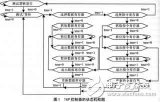


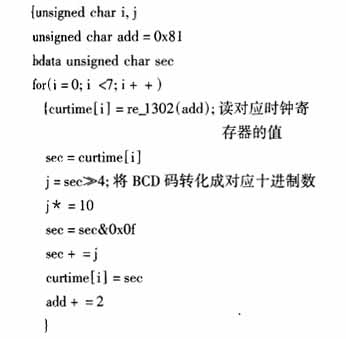
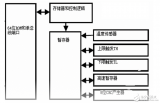






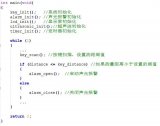

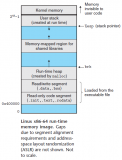










评论